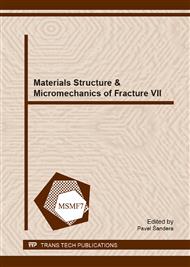p.777
p.781
p.785
p.789
p.793
p.797
p.801
p.805
p.809
Complex Evaluation of Fatigue Tests Results of Plain C30/37 and C45/55 Class Concrete Specimens
Abstract:
The aim of this paper is to summarize basic fatigue parameter values obtained for plain C30/37 and C45/55 class concrete specimens during dynamic tests. Selected approximation curves for relative mechanical-fracture parameter values over time − compressive cube strength, modulus of elasticity, effective fracture toughness and specific fracture energy − were used to determine the most accurate fatigue parameter values corresponding to the age of specimens at the time dynamic tests were performed. Three models are used for standard description of the S−N curve: the Weibull and Gumbel models developed by Castillo et al. as well as the power law equation. Fatigue properties were obtained from three point bending tests conducted on beam specimens (100×100×400 mm nominal size) with a central edge notch (depth 10 mm).
Info:
Periodical:
Pages:
801-804
Citation:
Online since:
November 2013
Keywords:
Price:
Сopyright:
© 2014 Trans Tech Publications Ltd. All Rights Reserved
Share:
Citation:


